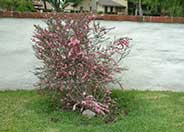
Common name:Clumping Gazania, Treasure Flower
Botanical name:Gazania rigens 'Sun Gold'
A moderately fast low groundcover, grey fuzzy leaves with bright yellow daisies held above the foliage. Prefers light soil and good drainage and full sun to light shade. Allow plants to be irrigated in mornings so that foliage is dry at dusk. Tolerant, and dependable for tough situations needing only some additional irrigation during the hottest seasons.

Common name:Broadmoor Juniper
Botanical name:Juniperus sabina 'Broadmoor'
This short shrub will grow 2-3' tall and 10' wide. It has soft, bright green leaves and is good for erosion control.

Common name:Eugenia Brush Cherry
Botanical name:Syzgium paniculatum
Eugenia is a large, broad shrub can reach 25'+ tall and has small, dark green leaves with white flowers that bloom throughout the seasons. Berry fruit can be a problem if it falls onto cars as they may get stained.

Common name:Flannel Bush, Fremontia cv.
Botanical name:Fremontodendron 'California Glory'
'California Glory' is an open and spreading evergreen shrub 10'-20' in height with many yellow flowers blooming in spring. It needs good drainage and little summer water. It is a native plant to California as the name suggests and it is drought tolerant. -Cornflower Farms

Common name:Gloriosa Daisy, perennial
Botanical name:Rudbeckia fulgida
This perennial will grow to 3' tall and has small, dark green leaves with yellow flowers that bloom in summer and fall.

Common name:Helene Strybing Manuka Tea Tree
Botanical name:Leptospermum scoparium 'Helene Strybing'
Helene Strybing Manuka Tea Tree has small, needle-like green leaves with showy, 1/2" rose-like flowers in winter and spring. These shrubs can be thinned to enhance their attractive branch structure and flaking bark. They need very little water once established. 'Helene Strybing' grows 6'-10' tall by 5'-8' wide. It has an open structure with deep pink blooms.
Dealing With Drought
More than half of the water used at your home is for outside purposes. Studies show that on average, half of the water used outdoors is wasted. The leading cause of waste is incorrectly set and poorly managed irrigation controllers. The second biggest cause of wastage is broken irrigation equipment that goes undetected. There are a few basic things you can do to make a big difference in your water use.
Click in the green box for more information
| Designer: | Noreen Driveway View |
Photographer: GardenSoft |
Soils and Compost:
Physical weed control, including mulching, or hand removal protects the watershed from harmful chemicals.
Water Saving Tip:
Mulching and adding compost to soil can minimize evaporation and help soil absorb and store water.
Integrated Pest Management:
Remove irrigation water and fertilizer from areas where you don't want weeds to grow.

